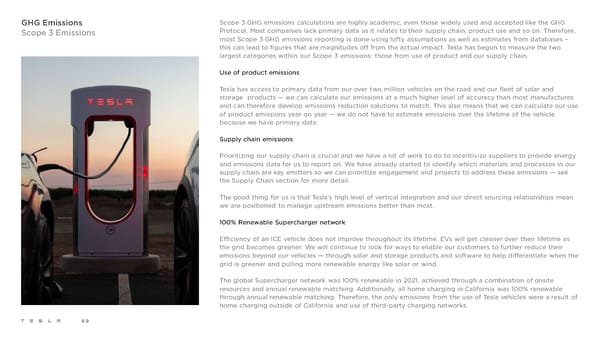GHG Emissions Scope 3 GHG emissions calculations are highly academic, even those widely used and accepted like the GHG Scope 3 Emissions Protocol. Most companies lack primary data as it relates to their supply chain, product use and so on. Therefore, most Scope 3 GHG emissions reporting is done using lofty assumptions as well as estimates from databases – this can lead to figures that are magnitudes off from the actual impact. Tesla has begun to measure the two largest categories within our Scope 3 emissions: those from use of product and our supply chain. Use of product emissions Tesla has access to primary data from our over two million vehicles on the road and our fleet of solar and storage products — we can calculate our emissions at a much higher level of accuracy than most manufactures and can therefore develop emissions reduction solutions to match. This also means that we can calculate our use of product emissions year on year —we do not have to estimate emissions over the lifetime of the vehicle because we have primary data. Supply chain emissions Prioritizing our supply chain is crucial and we have a lot of work to do to incentivize suppliers to provide energy and emissions data for us to report on. We have already started to identify which materials and processes in our supply chain are key emitters so we can prioritize engagement and projects to address these emissions — see the Supply Chain section for more detail. The good thing for us is that Tesla’s high level of vertical integration and our direct sourcing relationships mean we are positioned to manage upstream emissions better than most. 100% Renewable Supercharger network Efficiency of an ICE vehicle does not improve throughout its lifetime. EVs will get cleaner over their lifetime as the grid becomes greener. We will continue to look for ways to enable our customers to further reduce their emissions beyond our vehicles — through solar and storage products and software to help differentiate when the grid is greener and pulling more renewable energy like solar or wind. The global Supercharger network was 100% renewable in 2021, achieved through a combination of onsite resources and annual renewable matching. Additionally, all home charging in California was 100% renewable through annual renewable matching. Therefore, the only emissions from the use of Tesla vehicles were a result of home charging outside of California and use of third-party charging networks. 69
 Tesla 2021 Impact Report Page 68 Page 70
Tesla 2021 Impact Report Page 68 Page 70